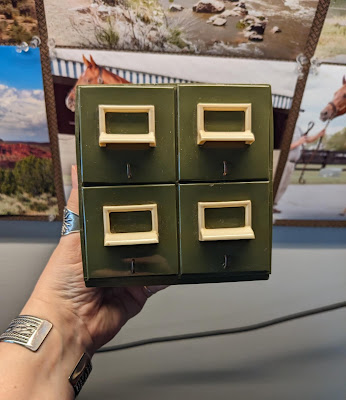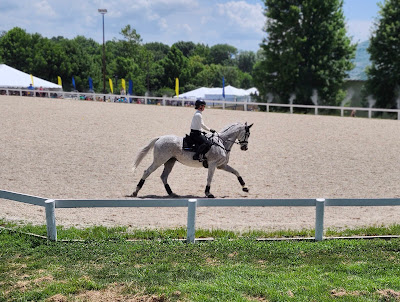Today, Wednesday, July 30th, happens to be the 100th anniversary of Pony
Penning, the annual round up of wild ponies on Assateague Island and
their swim across the narrow channel to Chincoteague Island off the coast of Virginia. The round up and subsequent auction of some of the ponies are undertaken to help control the population size of the Assateague herd, and the auction benefits the local volunteer fire
brigade. So this feels like an excellent day to celebrate Misty, the
most famous Chincoteague Pony of all time.
 |
| Misty and Marguerite Henry, photo from mistysheaven.com |
If you were a horse crazy kid like me, you probably read every horse
book you could get your hands on. Literary equines like the Black Stallion, Sham, Phantom, Harlequin Hullabaloo, Mokey, and the Crumb
fired my imagination, and I have a soft spot for the many model horses
inspired by my childhood storybook favorites. Not surprisingly,
Marguerite Henry's horse stories were in regular rotation on my reading
list.
Misty of Chincoteague is probably the best-known and
most-beloved of Henry's books. First published in 1947, it tells the
story of Paul and Maureen Beebe, orphaned siblings who are raised by
their grandparents on Chincoteague Island.
Paul is determined to capture the elusive mare The Phantom in the upcoming Pony Penning Days event. Despite a few hiccups and set-backs, Paul does manage to round up The Phantom, and he and Maureen are eventually able to buy her and the new filly at
her side, a palomino tobiano they name Misty. In truth, the book is more
about The Phantom and Paul's attempts to train her than it is about
Misty. Ultimately, the children release The Phantom back to her wild
herd when they realize she's unhappy in captivity, but Misty remains
with the Beebes.
The real Misty was actually born on Chincoteague
in 1946 at the Beebe's pony farm. Marguerite Henry visited Chincoteague
that same year for Pony Penning hoping to find inspiration for a new
book. She fell in love with a young Misty and convinced Grandpa Beebe to
sell the pony to her. When Misty was weaned, she was shipped to
Marguerite's home in Illinois where she lived for 10 years. Misty
eventually returned to Chincoteague and had three foals, Phantom Wings,
Wisp O' Mist, and Stormy. Misty lived out her life visiting with the
thousands of fans who came to see her and her offspring. You can read
all about Misty, her descendants, and the people who cared for her on
the wonderful Misty's Heaven website.
Marguerite's
book about Misty was an immediate success and won a number of literary
awards. In 1961, a movie based on the book was released to great
acclaim. The book, the sequels to the book (Sea Star: Orphan of Chincoteague and Stormy, Misty's Foal),
the movie, and the many promotional tours that Henry undertook with the
real pony and some of her relatives, cemented Misty's place in the
pantheon of famous literary horses. Not surprisingly, due to this
popularity, a Breyer model of Misty has remained in production in one
form or another since its debut in 1972.
Misty's transition from the printed page to a three dimensional plastic model was not a seamless one however. The real Misty was described as having a map of the United States on one side and a blaze shaped like the state of Virginia. Breyer worked with Marguerite to develop the model and would have had access to photos of the real pony as well as the illustrations in the book. So it's a bit of a mystery as to why Breyer's first attempts at duplicating Misty's pinto pattern were so off the mark. Several test runs with different patterns can seen in the Breyer catalogs in the early 1970s. Some of them appear to have been airbrushed free-hand with no mask, and none of them quite match the first production models.
A few of the oddball test models have made it into the hands of collectors. Fellow blogger Andrea Gurdon owned this unique glossy Misty. I suspect she was airbrushed freehand without a mask, and the edges of the pattern and the tendrils of the mane were neatened up with acetone at the factory.
Misty was originally sold individually or in a cute carrying case with a softbound copy of the book that inspired the model. The model pictured on the box is yet another test.
Misty's palomino color has varied hugely over the years, from a rich, nearly chestnut, honey shade to bright lemony yellow to a pale creamy gold, and all of the shades in between.
From the get-go, Misty was available as part of the gift set pictured above (made 1972-1981) and individually. (Her foal Stormy was added to the Breyer line up in 1977.)
 |
| Photo from https://www.breyervalueguide.com/ |
In 1984, an adorable flocked version of Misty and Stormy was offered through the Sears holiday catalog.
In 1992, the JC Penney holiday catalog offered an unusual Misty in "cold cast porcelain" which is not porcelain at all---it's just resin mixed with porcelain dust. (True porcelain is clay that has to be fired in a kiln to harden and hold a rigid shape. Resin is essentially a type of liquified plastic with various additive powders (i.e. porcelain dust, bronze filings, etc) that solidifies on its own when mixed correctly.) Only 1500 of these models were made, and a number of them broke in shipping. In recent years, many collectors have found that the paint on their cold cast Mistys is flaking off, likely because the resin bodies were not properly scrubbed to remove mold release and/or were not primered before painting. Interestingly, the catalog page shows a model with a face marking that is pretty true to that of the real pony, while the models that actually shipped have the usual round pinto spot around the eye. Most are a yellowy-palomino shade.
The following year, in a joint project with Hagen-Renaker, Breyer offered a true ceramic (fired and glazed earthenware) Misty model. The Performing Misty was made in 1993 only at Hagen-Renaker's factory in San Dimas, CA, and distributed by Breyer. The first examples were shipped attached to their stools, but due to significant breakage issues, Hagen-Renaker quickly switched to shipping the Mistys separate from their stools.
 |
| Photo from eBay |
Throughout the 1990s and early 2000s, Breyer offered Misty as a regular run, sometimes with her book and/or with her foal Stormy. A few special runs of similar sets were offered through various catalogs and retailers, but the models were no different than the regular versions.
 |
| Photo by Breyer |
Breyer has been associated with Misty of Chincoteague for more than 50 years, and the company has long been a supporter of the Misty of Chincoteague Foundation, an advocacy group that promotes literacy, reading, and the preservation of the places that Misty called home. Every year, part of the proceeds of the BreyerFest auction go to the foundation to help keep Misty's legacy alive. Breyer has also helped support the Museum of Chincoteague Island which successfully raised money through donations by horse lovers to buy the Beebe Ranch in 2023 to save it from developers.
It's a testament to Marguerite Henry's genius that the story of Misty still sparks the imagination of horse lovers, both young and old, all these decades later. What young horse-obsessed child doesn't dream of gentling a wild pony of their own and having madcap adventures? I know I certainly did. One of these years, I plan to make the trip to Chincoteague to see the famous pony swim and to visit all of the important places Misty and her offspring called home. And of course, I will definitely bring a Misty model along with me!







































